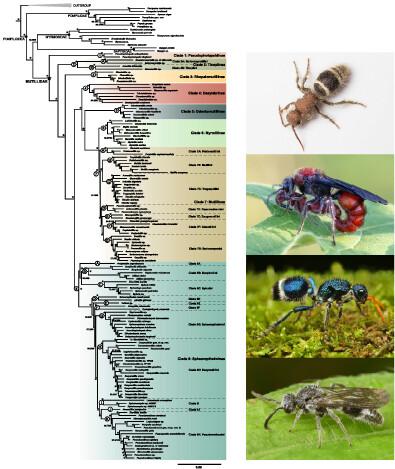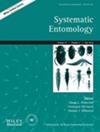绒蚁高等分类的系统基因组推断(膜翅目:绒蚁科)
摘要
茧蜂科(膜翅目)是一种种类丰富的有刺蜂,分布在世界各地。该科的高阶分类在历史上一直存在争议,部分原因是这些昆虫表现出极端的两性二态性,以及它们与其他具有无翅雌性的黄蜂类群在形态上的相似性。关于残肢科内部高级分类的现代假说完全基于形态学,而且,它们将桃蚜科作为残肢亚科。相反,一些基于分子的家庭水平的研究恢复了桃蚜科作为一个非残体分类单元。为了验证这些基于形态学的分类的有效性以及有争议的分类单元Myrmosinae的系统发育定位,我们使用超保守元件(UCEs)对残蝇科进行了系统发育研究。本研究用140个群内分类群代表了残足科所有已知的亚科和部落。采用最大似然准则(ML)和最大简约准则(MP),利用238,764个字符的对齐数据集,推断出该科和相关分类群的系统发育关系;这些各自分析的拓扑结构在很大程度上是一致的。基于形态学的肢解科现代高级分类与本研究在亚科水平上的系统发育结果基本一致,而部落分类则缺乏支持。在ML分析中,Myrmosinae亚科被恢复为Sapygidae的姐妹亚科,MP分析中被恢复为Sapygidae + Pompilidae的姐妹亚科;因此,它被提升到家庭水平,金雀花科,stat. 11。金雀花科的两个组成部落被提升到亚科水平,金雀花科,stat. 11。,和Myrmosinae, stat. 11。所有4个已被确认的残藤科部落都是非单系的;除Ctenotillini、Mutillini、smmicromyrmini和Trogaspidiini sensu stricto外,还发现了3个残系分支。为这些分支的成员建立了三个新的部落:pristomutilini Waldren, tribe .nov。, Psammothermini Waldren, trib.nov。zeugomutilini Waldren, trib. 11。所有三个已知的Sphaeropthalminae部落都是非单系的;除达螨属、假甲螨属和严格感球藻属外,还发现了另外6个球藻属分支。肢解亚族Ephutina:肢解亚族是多系的,其中Ephuta属群在Sphaeropthalminae中被发现,而Odontomutilla属群被发现是mymilinae +肢解亚的姐妹。因此,亚部落Ephutina从Mutillinae: Mutillini转移到Sphaeropthalminae, Ephutini, stat.nov。此外,Odontomutillinae分类群,stat. 11。从Ephutina的同义词上升到亚科水平。sphaeropthalmine部落Pseudomethocini被发现是多系的,Euspinoliina亚部落作为Sphaeropthalminae的一个独立分支被恢复;因此,Euspinoliina被提升为一个部落,Euspinoliini, stat.nov。,属球藻科。Apteromutillini是在Dasylabrini中发现的,被认为是Dasylabrinae的一个新同义词。最后,通过测年分析,推测了麻麻科(麻麻科、桃麻科、麻麻科和麻麻科)的年龄以及麻麻科亚科和部落的年龄。

The family Mutillidae (Hymenoptera) is a species-rich group of aculeate wasps that occur worldwide. The higher-level classification of the family has historically been controversial due, in part, to the extreme sexual dimorphism exhibited by these insects and their morphological similarity to other wasp taxa that also have apterous females. Modern hypotheses on the internal higher classification of Mutillidae have been exclusively based on morphology and, further, they include Myrmosinae as a mutillid subfamily. In contrast, several molecular-based family-level studies of Aculeata recovered Myrmosinae as a nonmutillid taxon. To test the validity of these morphology-based classifications and the phylogenetic placement of the controversial taxon Myrmosinae, a phylogenomic study of Mutillidae was conducted using ultraconserved elements (UCEs). All currently recognized subfamilies and tribes of Mutillidae were represented in this study using 140 ingroup taxa. The maximum likelihood criterion (ML) and the maximum parsimony criterion (MP) were used to infer the phylogenetic relationships within the family and related taxa using an aligned data set of 238,764 characters; the topologies of these respective analyses were largely congruent. The modern higher classification of Mutillidae, based on morphology, is largely congruent with the phylogenomic results of this study at the subfamily level, whereas the tribal classification is poorly supported. The subfamily Myrmosinae was recovered as sister to Sapygidae in the ML analysis and sister to Sapygidae + Pompilidae in the MP analysis; it is consequently raised to the family level, Myrmosidae, stat.nov. The two constituent tribes of Myrmosidae are raised to the subfamily level, Kudakrumiinae, stat.nov., and Myrmosinae, stat.nov. All four recognized tribes of Mutillinae were found to be non-monophyletic; three additional mutilline clades were recovered in addition to Ctenotillini, Mutillini, Smicromyrmini, and Trogaspidiini sensu stricto. Three new tribes are erected for members of these clades: Pristomutillini Waldren, trib.nov., Psammothermini Waldren, trib.nov., and Zeugomutillini Waldren, trib.nov. All three recognized tribes of Sphaeropthalminae were found to be non-monophyletic; six additional sphaeropthalmine clades were recovered in addition to Dasymutillini, Pseudomethocini, and Sphaeropthalmini sensu stricto. The subtribe Ephutina of Mutillinae: Mutillini was found to be polyphyletic, with the Ephuta genus-group recovered within Sphaeropthalminae and the Odontomutilla genus-group recovered as sister to Myrmillinae + Mutillinae. Consequently, the subtribe Ephutina is transferred from Mutillinae: Mutillini and is raised to a tribe within Sphaeropthalminae, Ephutini, stat.nov. Further, the taxon Odontomutillinae, stat.nov., is raised from a synonym of Ephutina to the subfamily level. The sphaeropthalmine tribe Pseudomethocini was found to be polyphyletic, with the subtribe Euspinoliina recovered as a separate clade in Sphaeropthalminae; consequently, Euspinoliina is raised to a tribe, Euspinoliini, stat.nov., in Sphaeropthalminae. The dasylabrine tribe Apteromutillini was recovered within Dasylabrini and is proposed as a new synonym of Dasylabrinae. Finally, dating analyses were conducted to infer the ages of the Pompiloidea families (Mutillidae, Myrmosidae, Pompilidae, and Sapygidae) and the ages of the Mutillidae subfamilies and tribes.

 求助内容:
求助内容: 应助结果提醒方式:
应助结果提醒方式:


